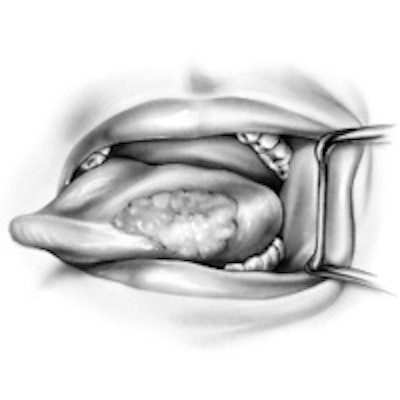
Young patients with recurrent squamous cell carcinoma (SCC) of the tongue have 100% fatality rates within 16 months of its appearance compared with a 50% three-year disease-specific survival among older patients, according to a new study in (Oral Oncology, October 2013, Vol. 49:10, pp. 987-990).
SCC of the tongue is one of the most common head and neck cancers; nearly 13,000 new cases occurred in the U.S. in 2012, according to the American Cancer Society. Incidence trends for the last few decades appear to be age-related, with several reports suggesting an increased incidence in young patients, particularly young white women.
The high rate of young patients diagnosed with SCC of the tongue is reflected in a 2000 retrospective review from the MD Anderson Cancer Center in Houston, which showed an increase in the proportion of patients younger than age 40 with the disease from 4% in 1971 to 18% in 1993 (Otolaryngology--Head and Neck Surgery, January 2000, Vol. 122:1, pp. 44-51). However, the prognostic significance of age at diagnosis for tongue cancer is controversial.
In the current study, Israeli researchers compared the clinical, pathological, and prognostic characteristics of the disease among patients younger than age 30 at presentation with those of patients older than age 60 at presentation. The study group included head and neck cancer patients who received glossectomies and neck dissections at Tel Aviv University from 1996 to 2012.
The researchers analyzed 113 patients: 16 (14.2%) were younger than 30 at diagnosis, 35 patients (31%) were between the ages of 31 and 60, and 62 (55%) were older than 60. The average follow-up was 31.3 months.
Findings
Comparison of the age groups revealed no sex predilection and no difference in histologic grade or rates of advanced T-stage, perineural and vascular invasion, or nodal extracapsular extension. None of the young patients had any cancer-related genetic syndromes or familial history of head and neck cancers.
The youngest patients had higher rates of regional metastases than the older patients (75% versus 19%, respectively; p < 0.001) and, correspondingly, TNM stage III-IV disease (81% versus 23%, respectively; p < 0.001). Only one patient (age 75) had distant metastases at presentation.
The researchers found that the rate of tumors deeper than 5 mm was higher among young patients (86%) compared with patients older than 60 (69%), although the difference was not statistically significant (p = 0.32).
Some 38 patients received adjuvant radiotherapy and/or chemotherapy. Both treatments were more common among young patients than patients older than 60 (75% and 56% versus 24% and 15%, p < 0.001 and p = 0.001, respectively).
There was no significant difference between the groups in overall or disease-free survival (p = 0.19 and p = 0.49, respectively). Recurrent disease was found in six patients in the younger group (38%) and 18 in the older group (29%) (p = 0.6). Mean time to recurrence was 10 months and 22 months, respectively (p = 0.12). Half of the recurrences in the younger group were distant compared with none in the older group (p = 0.01).
The risk for distant metastases is strongly associated with advanced nodal disease. The researchers noted that this association may explain the higher rate of distant metastases in young patients in this study, since 75% of these patients had a node-positive disease.
The researchers also examined the presence of the human papillomavirus (HPV) in tumor specimens from 12 patients younger than 35 years and in 20 patients older than 45, with carcinoma of the mobile tongue. They found that none of the patients in either group had carcinogenic subtypes of HPV such as HPV16 or 18, the types most commonly associated with HPV-positive oropharyngeal cancers.
Another unique feature of tongue cancer in young patients is the absence of traditional risk factors such as tobacco and alcohol use. Even in patients younger than 30 who smoke or drink, the duration of exposure is insufficient for the development of malignancy, the researchers noted. Studies suggest that smoking for 21 years may be necessary to increase the risk of oral cancer.
Conclusion
Recurrent disease in the younger group was associated with a 100% fatality rate within 16 months from appearance, compared with a 50% three-year disease-specific survival rate in the older group.
The results showed that tongue cancer in young patients is more likely to be diagnosed at an advanced stage owing to the higher rate of regional involvement, the researchers concluded. Histopathologic variables, such as tumor grade, depth of invasion, and lymphovascular spread, were similar in the two age groups. Disease-free survival and overall survival also were similar, and recurrences were found in approximately one-third of patients in both groups.
Two differences stand out: Distant failure was much more common in young patients than older patients (50% versus 0%, respectively); and all recurrences in the younger group led to death compared with the older group, in which three-year disease specific survival was 50%.
"Our comparison of younger patients (< 30 years) with older patients (> 60 years) revealed that younger age is associated with a higher rate of regional disease at presentation and aggressive recurrent disease," the researchers concluded.



















